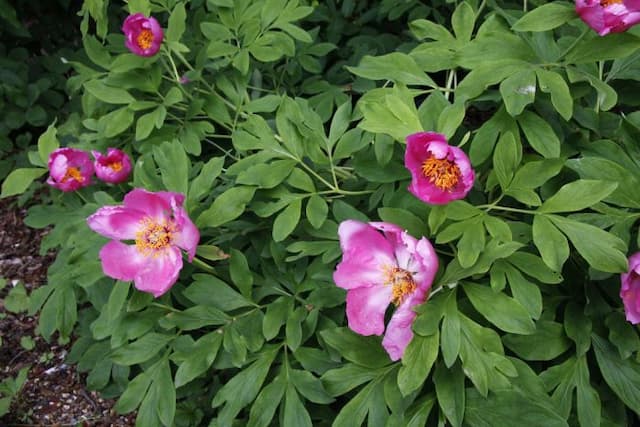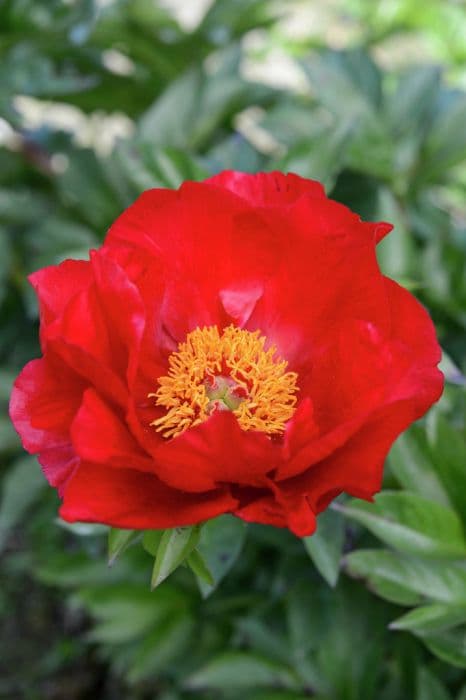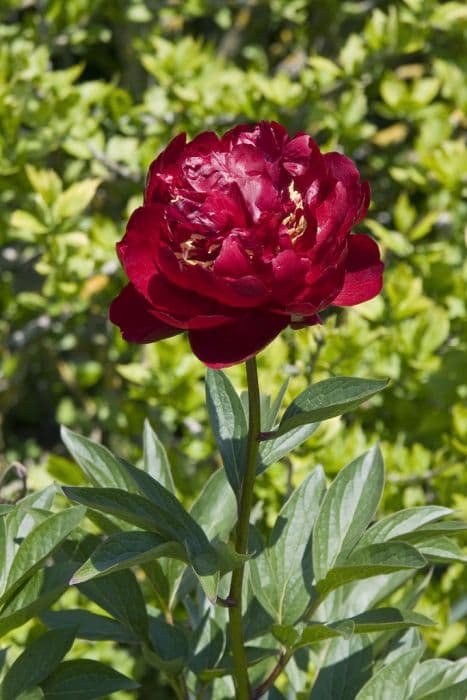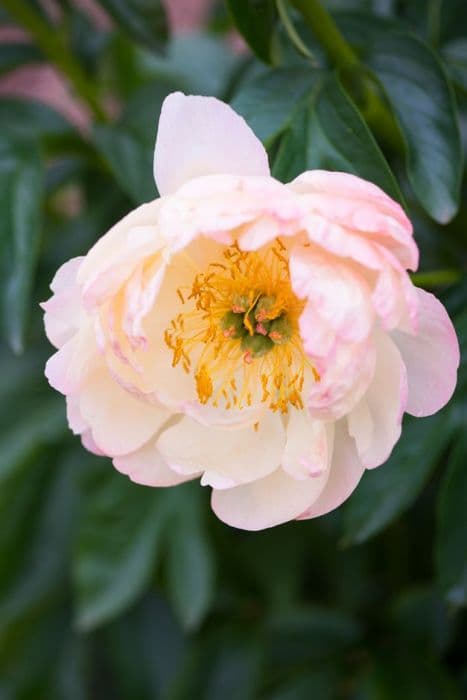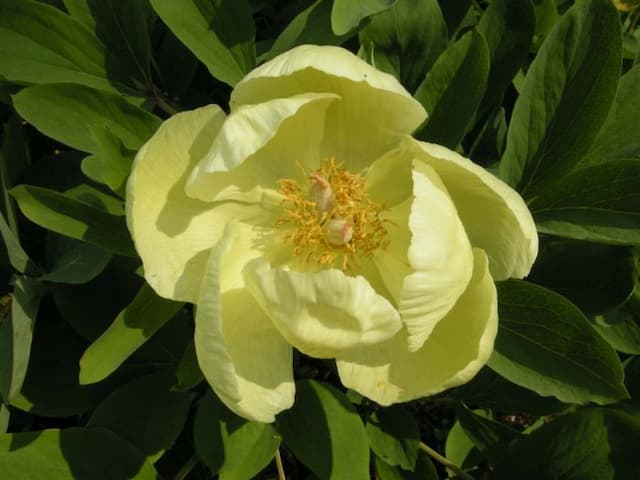Peony Paeonia 'Claire de Lune'

ABOUT
The 'Claire de Lune' peony is a delightfully elegant flowering plant. It boasts large, single blooms that present a soft, creamy yellow hue at their heart, gently transitioning to white toward the edges. These flowers exude a subtle fragrance that adds to their allure and they are adorned with bright golden-yellow stamens at their center, which provide a striking contrast against the pale petals. The plant's foliage is deep green, providing a lush backdrop for the delicate blossoms. With a graceful growth habit, the 'Claire de Lune' peony is a cherished variety for its aesthetic appeal, notably during its blooming season when it becomes a focal point of any garden space.
About this plant
 Names
NamesFamily
Paeoniaceae
Synonyms
Claire de Lune Peony
Common names
Paeonia 'Claire de Lune'.
 Toxicity
ToxicityTo humans
Peonies, including Paeonia 'Claire de Lune', are not considered highly toxic to humans. However, ingestion of peony parts, especially in large quantities, may lead to mild gastrointestinal upset, such as nausea, vomiting, and diarrhea. It is always best to avoid eating ornamental plants due to the potential for adverse effects.
To pets
Peonies, including Paeonia 'Claire de Lune', can be toxic to pets if ingested. Symptoms of peony poisoning in pets may include vomiting, diarrhea, and drooling. In severe cases of ingestion, it could potentially lead to depression and anorexia. It is recommended to keep pets away from peonies to avoid these negative health consequences.
 Characteristics
CharacteristicsLife cycle
Perennials
Foliage type
Deciduous
Color of leaves
Green
Flower color
Pale yellow
Height
2-3 feet [60-90 cm]
Spread
2-3 feet [60-90 cm]
Plant type
Herbaceous
Hardiness zones
3-8
Native area
Asia
Benefits
 General Benefits
General Benefits- Ornamental Value: Paeonia 'Claire de Lune', commonly known as Peony 'Claire de Lune', has attractive, pale-yellow flowers that add a soft, romantic touch to the garden.
- Landscape Design: With its lush foliage and large blooms, it serves as an excellent focal point in landscape design, especially in borders and flower beds.
- Cut Flowers: The blooms are long-lasting and make for beautiful cut flowers, which can be used in floral arrangements and bouquets.
- Wildlife Attraction: Peonies can attract beneficial insects, such as butterflies and bees, which are essential for pollination.
- Seasonal Interest: Peonies provide a display of vibrant color in late spring to early summer when many other plants are not yet in full bloom.
- Drought Tolerance: Once established, peonies are quite drought-tolerant, making them suitable for gardens in areas with occasional water shortages.
- Low Maintenance: Apart from initial planting and occasional feeding and watering, peonies require minimal day-to-day maintenance.
- Longevity: Peonies are long-lived perennials that can thrive for many years, even decades, in the same location without the need for replanting.
- Variety of Uses: Peonies are versatile and can be used in various garden settings, including cottage gardens, urban gardens, and formal landscapes.
- Cold Hardy: Peonies are very cold hardy and can survive in colder climates, making them suitable for a wide range of geographic locations.
 Medical Properties
Medical PropertiesThis plant is not used for medical purposes.
 Air-purifying Qualities
Air-purifying QualitiesThis plant is not specifically known for air purifying qualities.
 Other Uses
Other Uses- The petals of the peony 'Claire de Lune' can be used to create natural dyes for fabrics, imparting subtle colors ranging from soft pinks to plush maroons depending on the mordant used.
- When dried, the petals of the peony can be incorporated into potpourri mixes, offering a gentle fragrance and a touch of color to the blend.
- Peony petals can be added to bath soaks for a luxurious and calming bathing experience, as the petals infuse the water with their essence.
- The peony's sturdy stems can be used in the art of basket weaving once they are dried and treated, providing a unique texture and natural look.
- Peony blossoms can serve as natural confetti for outdoor celebrations, as they are biodegradable and offer an extravagant flair with their lush appearance.
- The large leaves of the peony can be used to create botanical prints on paper or fabric by using them as stamps or stencils for arts and crafts projects.
- Dried peony petals can be pressed and used in resin jewelry, encapsulating their beauty in pendants, earrings, or bracelets.
- Peony flowers can be used to decorate cakes or desserts, either as fresh adornments or crystallized with sugar for a more lasting effect.
- As a natural insect repellent, peony petals can be scattered around outdoor areas to ward off certain types of bugs due to their natural fragrance.
- The peony 'Claire de Lune' can be used in a sensory garden, providing a tactile experience with its lush, full blooms and a visual delight with its pastel shades.
Interesting Facts
 Feng Shui
Feng ShuiThe peony is often associated with wealth and honor in Feng Shui. To enhance the romance and prosperity in a space, peonies should be placed in the southwest area of a garden or home. However, be cautious as it is also believed that if placed in a bedroom, it can lead to affairs and marital strife, especially if they are red. It’s best used in living areas to attract positive energy and support social interactions.
 Zodiac Sign Compitability
Zodiac Sign CompitabilityThe peony is not used in astrology practice.
 Plant Symbolism
Plant Symbolism- Prosperity: Peonies, in general, are often associated with wealth and good fortune, making them popular in celebrations and for gifts.
- Romance: With their lush, full, rounded blooms, peonies are frequently used in wedding bouquets and are symbols of romantic love and a happy marriage.
- Beauty in all forms: The peony 'Claire de Lune' with its delicate color and form enhances the traditional association of peonies with beauty, appreciating both inner and outer charm.
- Compassion: Peonies can also symbolize compassion and empathy, as their full and generous blooms suggest a nurturing and giving spirit.
- Honor: In certain cultures, peonies embody honor and high value, recognizing the integrity and importance of individuals.
 Water
WaterPeonies like 'Claire de Lune' should be watered deeply once a week, providing about 1 inch of water each time, which is roughly equivalent to 0.623 gallons per square foot. The soil should be allowed to dry out somewhat between waterings to prevent root rot. During the growing season, especially when plants are setting buds and blooming, ensure consistent watering. If rainfall is adequate, additional watering may not be necessary. However, in the absence of rainfall, make sure to water the plants to maintain soil moisture, particularly in hot and dry conditions.
 Light
LightPeonies such as 'Claire de Lune' thrive in a location that offers full sun to light shade. They need at least six hours of sunlight each day to bloom well. The best spot is where they can receive morning sunlight and some afternoon shade, especially in hotter climates, to protect the blooms from wilting too quickly in the intense heat.
 Temperature
Temperature'Claire de Lune' peony is hardy and can survive a wide temperature range. These plants are cold-hardy and can tolerate winter temperatures as low as -20 degrees Fahrenheit but prefer a growing season with temperatures ranging between 65 and 75 degrees Fahrenheit. Extreme heat above 85 degrees Fahrenheit may affect the plant's blooming process and overall health. Ensuring a good mulch layer will help regulate soil temperature.
 Pruning
PruningPrune 'Claire de Lune' peony plants after the blooms have faded, typically in the late summer or early fall. This helps prevent disease and encourages healthy growth for next season. Cut the foliage to the ground in the fall once it turns brown, which is also a good time to deadhead any spent flowers during the blooming season to promote further blooming.
 Cleaning
CleaningAs needed
 Soil
SoilPeonies, including 'Claire de Lune', thrive best in well-drained, fertile soil with a neutral to slightly acidic pH of 6.5 to 7.0. A mix of garden loam, compost, and perlite can provide the necessary structure and nutrients. A layer of mulch helps retain moisture and keeps the roots cool.
 Repotting
RepottingPeonies like 'Claire de Lune' are typically not repotted frequently as they are long-lived perennials that prefer to be undisturbed. Repotting or dividing should only be done every 5 to 10 years if necessary to rejuvenate or propagate the plant.
 Humidity & Misting
Humidity & MistingPeonies including 'Claire de Lune' do not require high humidity and are quite tolerant of a range of humidity levels. Average ambient humidity is usually adequate for these plants. However, good air circulation is important to prevent fungal diseases.
 Suitable locations
Suitable locationsIndoor
Provide bright light but avoid direct intense sun.
Outdoor
Plant in full sun, fertile soil, water deeply.
Hardiness zone
3-8 USDA
 Life cycle
Life cycleThe Paeonia 'Claire de Lune', commonly known as Peony 'Claire de Lune', begins its life cycle when the seeds are sown or tubers are planted in the soil during late fall or early spring. Upon germination, the plant emerges as a small shoot and gradually develops a set of true leaves, focusing on root and foliage growth throughout spring and early summer. It enters a vegetative stage where it builds up energy through photosynthesis in its lush foliage. By its third year, the peony reaches maturity and starts producing its characteristic large, creamy yellow flowers typically in late spring to early summer. Once the blooming period is over, the plant sets seed, which, if not harvested, falls to the ground to potentially give rise to new plants. The peony then enters dormancy in the late fall as foliage dies back, conserving energy in its underground tuber to survive the winter and restart the cycle come next spring.
 Propogation
PropogationPropogation time
Late winter to early spring
The ideal time to propagate the peony 'Claire de Lune' is in the fall when the plant is entering dormancy. The most popular method of propagation is by division, which involves carefully digging up an established peony clump and gently dividing it into smaller sections with at least three to five eyes, which are the points from which new shoots will grow. Each section should have a good amount of roots. The divisions are then replanted into well-prepared soil, ensuring that the eyes are no more than 2 inches (about 5 cm) below the surface to prevent them from being planted too deeply, which can hinder blooming. This method not only helps to create new plants but also rejuvenates older ones that might have become too large or are not flowering as prolifically.
